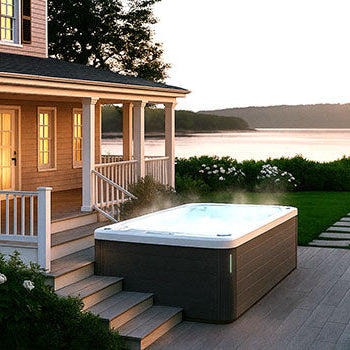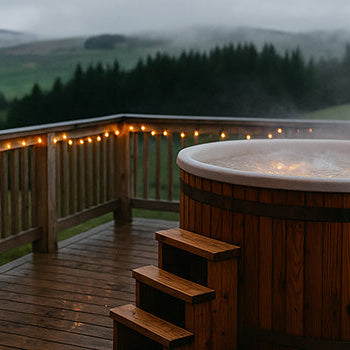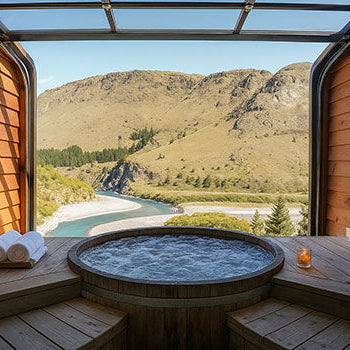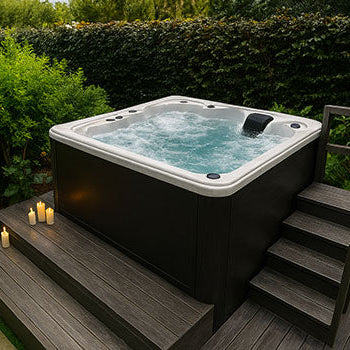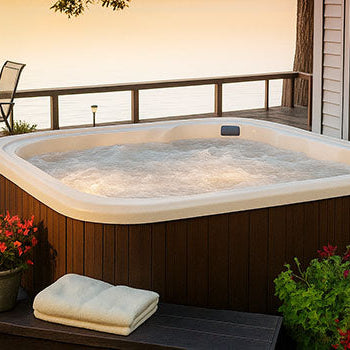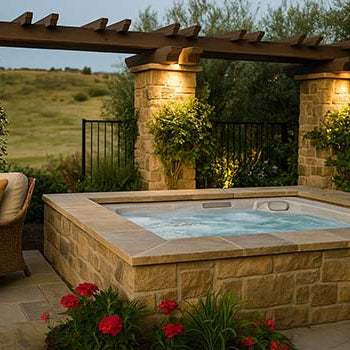Torn between sweating it out in a sauna or floating in a fizzing tub like a stress-free marshmallow?
Here’s the quick take: hot tubs win for everyday comfort, joint relief, and all-around bliss; especially if you go for an acrylic model, a rustic wooden tub, or a sturdy rotomoulded option.
But don’t count saunas out just yet. They’re dry, toasty powerhouses for heart health and detox.
Curious which suits your life best? Let’s dive into the details and help you make your dream home spa a reality.

Understanding the Basics: Dry Heat vs. Wet Heat
How Saunas Work (Traditional, Infrared - Dry Heat)
A sauna is like stepping into a warm wooden cabin built just for your sweat glands.
Traditional saunas heat the air using electric heaters or hot stones. The temperature? A fiery 70 to 100°C.
Infrared saunas are a little different. Instead of blasting hot air, they use infrared panels to warm your body directly. That means less air heat but just as much sweat.
Both types kick your heart rate up and leave you drenched in a detoxifying glow.
How Hot Tubs Work (Heated Water, Hydrotherapy Jets - Wet Heat)
Hot tubs are all about soaking your cares away.
Water is heated to around 37–40°C, then comes the magic, hydrotherapy jets. They massage your muscles while you’re gently suspended in water.
Whether you’re unwinding in a sleek acrylic spa, hopping into a rugged rotomoulded tub, or enjoying the charm of a classic wooden one, the experience is soothing, immersive, and deeply relaxing.
Comparing Potential Health Benefits
Sauna Benefits (Deep Sweating, Cardiovascular Effects, Relaxation)
Saunas turn your body into a calorie-burning, circulation-boosting machine.
That deep, dry heat makes you sweat, hard. This isn’t just a detox trend; it mimics a cardio workout by raising your heart rate and increasing blood flow.
Studies even suggest regular sauna use can lower blood pressure and reduce the risk of heart disease.
It’s like going for a brisk walk, without leaving the room. Oh, and mentally? That quiet heat feels like a reset button.
Hot Tub Benefits (Muscle/Joint Pain Relief via Buoyancy/Jets, Relaxation, Sleep Aid)
If your muscles are aching, the hot tub's your best friend.
The water lifts your body, taking the pressure off joints. Add jets, and you’ve got a warm massage that melts away stiffness, whether it’s post-workout pain or arthritis flaring up.
Hot tubs also help you wind down before bed. A 20-minute soak can improve sleep quality, no sleep apps required.
Overlapping Benefits (Stress Reduction, Circulation Improvement)
Both options help you hit the brakes on stress.
They improve circulation, reduce cortisol levels (your stress hormone), and give your mind some breathing room.
In short, sauna or tub, you’ll come out feeling like you’ve just returned from holiday.
Differences in Therapeutic Action
Saunas work from the inside out. They use dry heat to raise your core temperature and trigger a deep sweat. It’s intense, but powerful.
Hot tubs, meanwhile, soothe from the outside in. The warm water and buoyancy ease pressure on joints while jets physically work your muscles.
One’s like cardio for your organs, the other’s physical therapy for your body.
Comparing the User Experience
The Feeling of Dry Heat vs. Water Immersion and Massage
Imagine sitting in a log cabin with the heat steadily climbing, sweat pouring, and your thoughts slowly quieting. That’s a sauna. It’s hot. It’s dry. And oddly satisfying.
Now picture sliding into warm bubbling water. Muscles relax. Jets knead your back. You’re basically soup, happy, relaxed, human soup.
Social Aspects: Group Use Comparison
Hot tubs are the life of the party. Great for chats, drinks, and relaxing with friends.
Saunas? More like a group meditation. You sit, sweat, maybe whisper. Social, sure. But it’s the quiet kind.
So if you're planning hot tub wine nights vs solo sauna zen time, your choice is clear.
Typical Session Duration and Temperature Ranges
Saunas are hot, really hot. Most people stay in for 10 to 20 minutes at 70–100°C. That’s enough to sweat it out and feel refreshed.
Hot tubs are milder, staying around 37–40°C. You can comfortably soak for 15–30 minutes without turning into a raisin.
Hot tubs often win the ‘stay-and-linger’ game.

Practical Considerations: Installation and Space
Sauna Installation Requirements (Indoor/Outdoor, Power, Size)
Saunas are surprisingly flexible. You can install one indoors or outdoors.
Infrared saunas plug into a standard socket, while traditional ones might need a dedicated circuit. Just make sure the space is dry and well-ventilated.
Sizes vary, some are small enough for a bathroom corner, others fit the whole family.
Hot Tub Installation Requirements (Base, Power, Water, Size, Outdoor Focus)
Hot tubs, especially the larger acrylic or rotomoulded types, need a bit more prep.
They’re usually installed outdoors on a level, sturdy surface like decking or concrete. You’ll need water access, proper drainage, and a dedicated power supply.
Wooden tubs may have simpler needs, but heating and water care still matter.
Space Needs Compared
Saunas generally need less room, around 2–3 square metres.
Hot tubs require 4–6 square metres or more, plus clearance around them for maintenance.
If you’re tight on space, a sauna is your compact wellness retreat. If you've got the garden space, the hot tub's ready to shine.
Comparing Costs: Purchase, Installation, and Running Costs in the UK
Initial Purchase and Installation Cost Ranges Compared
Here’s a ballpark:
Hot tubs usually cost more upfront, especially high-spec acrylic models. Wooden tubs and rotomoulded options may offer more value for money depending on features.
Estimated Running Costs (Electricity Usage Comparison)
Saunas heat quickly and only when in use. They’re cheaper to run, around £20–£40 a month.
Hot tubs keep water warm constantly, which uses more power. Expect £40–£80 monthly, depending on insulation and frequency of use.
Water and Chemical Costs (Hot Tub Only)
Hot tubs need ongoing care. You’ll be changing the water, balancing chemicals, cleaning filters, and more.
Budget around £150–£300 annually for supplies.
Saunas skip all this, you just wipe them down now and then.
Maintenance Requirements Compared
Sauna Maintenance (Wiping Down, Heater Check)
Saunas are low effort.
Wipe the benches after use. Check the heater now and then. That’s mostly it.
Infrared models are even easier, no stones, no water, just simple upkeep.
Hot Tub Maintenance (Water Chemistry, Filters, Cleaning, Draining)
Hot tubs are more high-maintenance.
You’ll need to test water regularly, add chemicals, clean filters, and drain and refill every few months.
It takes more time, but the reward is bubbly perfection every time you soak.
| Feature |
Sauna |
Hot Tub |
| Heat Type |
Dry |
Wet |
| Health Focus |
Cardiovascular, detox |
Muscle/joint relief, relaxation |
| Space Needed |
Smaller |
Larger |
| Maintenance |
Low |
Moderate–High |
| Cost to Run |
Lower |
Higher |
| Social Use |
Quiet, meditative |
Chatty, social |
| Setup |
Indoor/outdoor |
Primarily outdoor |
Which is "Better"? Choosing Based on Your Priorities
Choose a Sauna If You Prefer Dry Heat, Deep Sweating, Simpler Maintenance
Go sauna if you love a quick, intense heat session and don’t want to fuss with water or chemicals.
It’s clean, compact, and perfect for solo relaxation or heart health routines.
Choose a Hot Tub If You Prefer Water Immersion, Massage Jets, Hydrotherapy for Joints/Muscles
If floating in warm water while jets work their magic sounds like heaven, pick a hot tub.
They’re ideal for recovery, relaxation, and shared experiences.
Whether it’s an acrylic, rotomoulded, or wooden model, there’s one to suit every style.
Considering Personal Preference and Desired Benefits
Your perfect choice depends on your goals.
Want to sweat out toxins, boost heart health, and keep maintenance low? Sauna.
Prefer muscle relief, longer soaks, and water therapy? Hot tub.
No wrong answers here, just the one that suits your lifestyle best.

Conclusion: Sauna and Hot Tub Offer Different Experiences and Benefits
So, what’s better?
Hot tubs offer more versatility and social relaxation, while saunas score high for heart health and simplicity.
Either way, you’re stepping into a healthier, more relaxed version of yourself.
Build your wellness sanctuary, one sweat or soak at a time.
